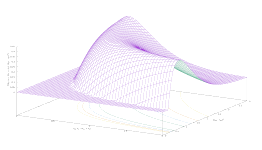
https://unsplash.com/photos/an-abstract-image-of-a-sphere-with-dots-and-lines-nGoCBxiaRO0?utm_content=creditShareLink&utm_medium=referral&utm_source=unsplash
Backpropagation is a generalization of the Delta rule to be able to take into account non-linear functions.
Suppose a differentiable function of the input vector
y_{k}^{p}=f(s_{k}^{p})where k represents the k-th unit of the network and p the p-th pattern. f (s_ {k} ^ {p}) is called activation function, and depends on a linear combination of the weights and outputs of the units of the previous layer of the network, which become the inputs for the unit k. Of course, y_ {k} ^ {p} is the output generated by the network for the k-th unit, according to the function s_ {k} ^ {p}
s_{k}^{p}=\sum_{j}w_{jk}y_{j}^{p}+\theta_{k}The summation extends to all units of the level immediately preceding the one in which unit k is located
j=k-1
\theta_ {k} is the bias term. It is associated to the layer in which the unit k is located and not to the layer j.
We want to find the weight variation rule that causes a decrease in the error
\Delta_{p}w_{jk}=-\gamma\frac{\partial E^{p}}{\partial w_{jk}}being \gamma a constant of proportionality called learning rate. Using squared error as measure of error
E^{p}=\frac{1}{2}\sum_{o=1}^{N_{o}}(t_{o}^{p}-y_{o}^{p})^{2}where the error is measured on all output units as the difference between the value generated by the network, y_ {o} ^ {p}, and the target value t_ {o} ^ {p}. The factor \frac {1} {2} is arbitrary and is introduced to be canceled with the quadratic exponent during derivation. This allows a slightly more simplified final expression.
The total error is the sum of the quadratic error of the set of patterns
E=\sum_{p}E^{p}According to the chain rule
\frac{\partial E^{P}}{\partial w_{jk}}=\frac{\partial E^{p}}{\partial s_{k}^{p}}\frac{\partial s_{k}^{p}}{\partial w_{jk}}from the equation which connects the output of one unit and the weighted sum of the units of the previous layer, we get
\frac{\partial s_{k}^{p}}{\partial w_{jk}}=y_{j}^{p}We define the other derivative in the equation as
\frac{\partial E^{p}}{\partial s_{k}^{p}}=-\delta_{k}^{p}and we get
\Delta_{p}w_{jk}=\gamma\delta_{k}^{p}y_{j}^{p}\delta_ {k} ^ {p} exists for every unit on the network. It is possible to compute \delta_ {k} ^ {p} through a recursive procedure that propagates the errors back through the network, starting from the output units where the error is computable since the target value is known.
To calculate \delta_ {k} ^ {p} we divide the derivative of the equation, using the chain rule, into two contributions: one that reflects changes with the variation of the input and another that reflects changes with the variation of the output
\delta_{k}^{p}=-\frac{\partial E^{p}}{\partial s_{k}^{p}}=-\frac{\partial E^{p}}{\partial y_{k}^{p}}\frac{\partial y_{k}^{p}}{\partial s_{k}^{p}}and from the definition of activation function
\frac{\partial y_{k}^{p}}{\partial s_{k}^{p}}=f'(s_{k}^{p})To calculate \frac{\partial E^{p}}{\partial y_{k}^{p}}, we consider two cases.
k is a network output unit
\frac{\partial E^{p}}{\partial y_{o}^{p}}=\frac{\partial}{\partial y_{o}^{p}}\left[\frac{1}{2}\sum_{o=1}^{N_{o}}(t_{o}^{p}-y_{o}^{p})^{2}\right]=-(t_{o}^{p}-y_{o}^{p})and therefore
\delta_{o}^{p}=(t_{o}^{p}-y_{o}^{p})f'(s_{o}^{p})k is a hidden unit
For a hidden unit k = h we do not know the contribution of that unit to the output of the network. However, we can write the error as a function of the input of the hidden units to the output units
E^{p}=f(s_{1}^{p},s_{2}^{p},\ldots,s_{j}^{p},\ldots)and using the chain rule
\begin{array}{rcl} \frac{\partial E^{p}}{\partial y_{h}^{p}} & = & \sum_{o=1}^{N_{o}}\frac{\partial E^{p}}{\partial s_{o}^{p}}\frac{\partial s_{o}^{p}}{\partial y_{h}^{p}}\\ & = & \sum_{o=1}^{N_{o}}\frac{\partial E^{p}}{\partial s_{o}^{p}}\frac{\partial}{\partial y_{h}^{p}}\left(\sum_{j=1}^{N_{h}}w_{jo}y_{j}^{p}\right)\\ & = & \sum_{o=1}^{N_{o}}\frac{\partial E^{p}}{\partial s_{o}^{p}}w_{ho}\\ & = & -\sum_{o=1}^{N_{o}}\delta_{o}^{p}w_{ho} \end{array}we obtain
s_{h}^{p}=f'(s_{h}^{p})\sum_{o=1}^{N_{o}}\delta_{o}^{p}w_{ho}




